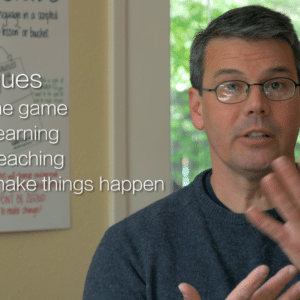
Mister Rogers, master of the Same Conversation, and icon of Intermediate level language proficiency.
You’re fluency hunting a fluent fool, and choose the most common activity in that skill to start at the beginning with the simplest level of performance, that first bite-sized piece. For the context you find it in, and driven by a few of your favorite things, you create a set-up and build a same conversation that you will return to over and over, the foundation of your travels with charlie as you climb the proficiency scale.
As you climb the scale you create new same conversations in this same way, each appropriate to the new level of proficiency you’ve reached, each opening up new interactions and capacities within the overall skill, building on each other.
Technique Same Conversation is the natural result of applying fundamental parent techniques such as obviously!, fluency, TPR, limit, copy-cat, and start at the beginning. A same conversation is an emergent property of these techniques.
It is a consistent, repetitive, reproducible, incrementally improving interaction that begins with the smallest bite-sized piece appropriate to its place in the overall travels with charlie.
Same conversations are built on what already happens, what is already habitual, accelerated by technique These Are a Few of My Favorite Things (the players’ favorite subjects, objects, and environment).
Same conversations are not level specific; they can be foundational conversations that truly start at the beginning (like learning to drive in an expansive parking lot, bowing rhythms on a fiddle without any melody, playing Tee-ball, etc.), or they can be experiences along the way to Superior proficiency (driving in a neighborhood before on a highway, learning to fiddle the melody “Give Me a Chaw of Tobacco” before “Old Corn Liquor”, playing Little League baseball before Junior League).
Every routine too can be seen as a same conversation, as a coherent skill-based interaction; getting dressed, commuting, making and eating dinner, filing income taxes.
Ritual and ceremony are often expressions of the most powerful application of accelerated learning techniques onto a same conversation, such as weddings, funerals, graduations, boot camps, and so on. These rituals must be relied upon to deliver competent, familiar, comforting interactions, even for participants totally new to them.
Introducing the technique in language acquisition
Short: “Technique: Same Conversation. A same conversation is any conversation that we have over and over, to build fluency in our target language.”
Long: “It’s best to build our same conversations on things we already habitually do, with objects and situations we are already familiar with. It’s especially helpful to include a few of your favorite things in these conversations, whether chosen by the language hunter, or the fluent fool you’re hunting.”
Applying the technique to language acquisition
As mentioned before, same conversations are built and improved by applying as many techniques as possible to them. Your overall goal, as a language hunter, is to use same conversations as a guide for how to break up your target language into achievable pieces, looking at the favorite and habitual activities of both you and your fluent fool.
But what about…?
Same conversations are the bedrock of fluent proficiency; new players may want to skip them or degrade the consistent, repeating quality of them.
- tq Último means players cannot proceed to the next conversation, until they can teach another player to lead the current one. This is kind of a mind-bender, so we’ll repeat it: in a community of play, a game leader only progresses to the next conversation, when they can pass off leadership of their current game to the next player. Language Hunters who are hunting alone, with no community of play supporting them, clearly can’t implement Último, but they know that generating such a community of play is a major accelerator just waiting to be implemented.




